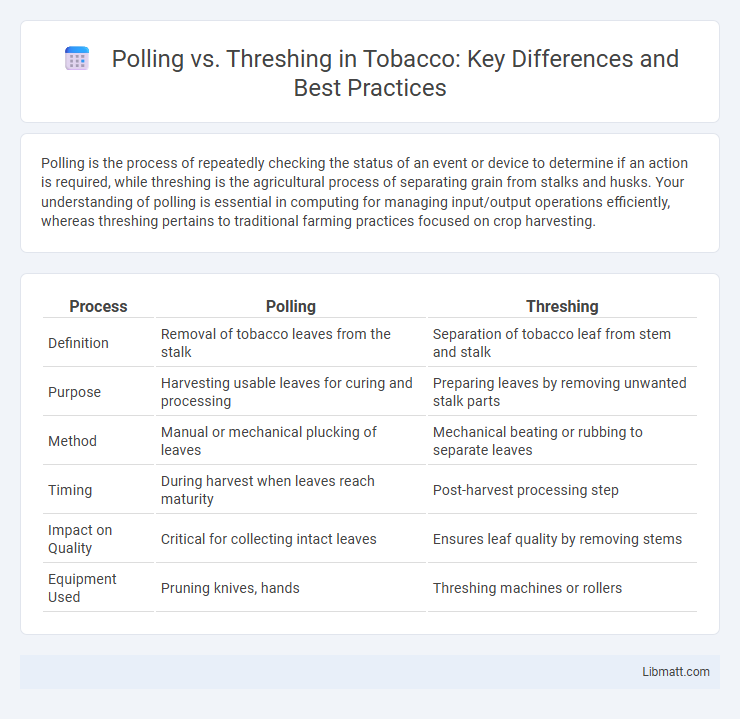Polling is the process of repeatedly checking the status of an event or device to determine if an action is required, while threshing is the agricultural process of separating grain from stalks and husks. Your understanding of polling is essential in computing for managing input/output operations efficiently, whereas threshing pertains to traditional farming practices focused on crop harvesting.
Table of Comparison
| Process | Polling | Threshing |
|---|---|---|
| Definition | Removal of tobacco leaves from the stalk | Separation of tobacco leaf from stem and stalk |
| Purpose | Harvesting usable leaves for curing and processing | Preparing leaves by removing unwanted stalk parts |
| Method | Manual or mechanical plucking of leaves | Mechanical beating or rubbing to separate leaves |
| Timing | During harvest when leaves reach maturity | Post-harvest processing step |
| Impact on Quality | Critical for collecting intact leaves | Ensures leaf quality by removing stems |
| Equipment Used | Pruning knives, hands | Threshing machines or rollers |
Introduction to Polling and Threshing
Polling is a method where a central device repeatedly checks the status of multiple connected devices to manage communication efficiency. Threshing refers to the process of separating grain from stalks and husks, integral to agricultural harvesting. Both polling and threshing play crucial roles in their respective fields--polling in data communication protocols and threshing in crop processing techniques.
Defining Polling: Concepts and Applications
Polling refers to the process of repeatedly checking the status or availability of a resource or event by actively sending requests at regular intervals. It is commonly used in network communications, embedded systems, and user interface event handling to detect changes or responses without waiting indefinitely. Polling ensures timely data retrieval but can lead to inefficiency and increased latency compared to interrupt-driven or event-based methods like threshing.
Understanding Threshing: Key Principles
Threshing separates grain from stalks and husks using mechanical or manual methods, crucial in post-harvest processing. Proper threshing ensures grain quality by minimizing damage and contamination, impacting yield and market value. Understanding threshing principles helps you optimize efficiency and maintain the integrity of harvested crops.
Core Differences Between Polling and Threshing
Polling involves repeatedly checking the status of a device or resource at regular intervals, while threshing is the process of separating valuable data from irrelevant or noisy information within a stream. The core difference lies in polling's active querying approach versus threshing's selective filtration mechanism. Your system efficiency improves significantly when the right method is applied according to data acquisition needs.
Advantages of Polling in Data Processing
Polling offers advantages in data processing by providing consistent and predictable timing for status checks, ensuring real-time responsiveness to device signals. It simplifies system design by avoiding complex interrupt management, reducing software overhead and potential synchronization issues. Your applications benefit from easier debugging and maintenance as polling follows a straightforward, sequential procedure.
Benefits of Threshing for Efficiency
Threshing significantly enhances agricultural efficiency by quickly separating grain from stalks and husks, reducing manual labor and time consumption compared to polling. This mechanized process increases productivity by enabling farmers to process larger quantities of crops in less time, leading to faster post-harvest operations. Your farming activities can benefit from threshing through improved yield quality and minimized grain loss during separation.
Use Cases: When to Choose Polling
Polling is ideal for applications requiring consistent monitoring of event status or data availability, such as checking sensor outputs in IoT devices or periodically verifying server health in network management. It suits scenarios where system resources can support regular querying without significant overhead and timely updates are crucial but do not demand instant notification. Choose polling when predictable intervals, controlled resource usage, and simple implementation outweigh the need for real-time responsiveness offered by event-driven approaches like threshing.
Use Cases: When Threshing is Preferred
Threshing is preferred in use cases where data transformation and aggregation are required to summarize raw input into actionable insights, such as processing large datasets to extract meaningful patterns or consolidating time-series data for trend analysis. It excels in scenarios that need complex event processing and in systems where real-time data consolidation reduces computational load. Your applications involving sensor data fusion, financial transaction summarization, or log data aggregation benefit significantly from threshing due to its ability to efficiently reduce redundancy and enhance signal clarity.
Common Challenges and Solutions
Polling and threshing both face challenges related to efficiency and accuracy under varying environmental conditions. Polling may experience latency issues due to frequent data requests, while threshing risks grain damage and losses during mechanical processing. Implementing automated sensors in polling and adjusting machine settings based on crop type can mitigate these issues, enhancing operational performance and yield quality.
Choosing the Right Approach for Your Needs
Polling involves actively querying a device or process at regular intervals to check its status, offering straightforward implementation but potentially higher resource consumption. Threshing uses event-driven signals to trigger actions only when specific conditions arise, optimizing efficiency by reducing unnecessary processing. Your choice between polling and threshing should consider factors like system responsiveness, resource availability, and real-time requirements to align with your project's performance goals.
polling vs threshing Infographic

 libmatt.com
libmatt.com